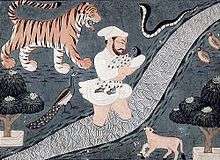Harela mela
Harela Mela is a fair takes place every year from 16 July to 21 in Ramlila Ground of Bhimtal on occasion of famous Harela festival of Kumaun, Uttarakhand.
Observance
Harela Mela is organised in the Ramlila Ground of Bhimtal in Mallital area. Baishakhi Purnima day brings rejoicing near Lokhamtal while Kainchi temple premises is gay on 15 June. Kakrighat has Somnath Fair on the last Monday of Baishakh, Garjia is full of festivity on Kartik Purnima day in the month of November. Nandashtami Festival is observed with full devotion in the district, fairs are organised at Nainadevi temple Nainital and Bhowali. The Kumaoni people use the fortnight of Shradha in late September or early October to remember their dead ancestors.
Legends
Many Puranas tells Krishna's life-story or some highlights from it. Two Puranas, the Bhagavata Purana and the Vishnu Purana, that contain the most elaborate telling of Krishna’s story and teachings are the most theologically venerated by the Gaudiya Vaishnava schools.[1] Roughly one quarter of the Bhagavata Purana is spent extolling his life and philosophy.
Yāska's Nirukta, an etymological dictionary around the 5th century BC, contains a reference to the Shyamantaka jewel in the possession of Akrura, a motif from well known Puranic story about Krishna.Satha-patha-brahmana and Aitareya-Aranyaka, associate Krishna with his Vrishni origins.[2] In early texts, such as Rig Veda, there are no obvious references to Krishna, however some, like Ramakrishna Gopal Bhandarkar attempted to show that "the very same Krishna" made an appearance, e.g. as the drapsa ... krishna "black drop" of RV 8.96.13.[3]
This summary is based on details from the Mahābhārata, the Harivamsa, the Bhagavata Purana and the Vishnu Purana. The scenes from the narrative are set in north India, mostly in the present states of Uttar Pradesh, Bihar, Haryana, Delhi and Gujarat.

Traditional belief based on scriptural details and astrological calculations gives the date of Krishna's birth, known as Janmashtami,[4] as either 18 or 21 July 3228 BC.[5][6] Krishna belonged to the royal family of Mathura, and was the eighth son born to the princess Devaki, and her husband Vasudeva. Mathura was the capital of the Yadavas (also called the Surasenas), to which Krishna's parents Vasudeva and Devaki belonged. The king Kamsa, Devaki's brother,[7] had ascended the throne by imprisoning his father, King Ugrasena. Afraid of a prophecy that predicted his death at the hands of Devaki's eighth son, he had locked the couple into a prison cell. After Kamsa killed the first six children, and Devaki's apparent miscarriage of the seventh, being transferred to Rohini as Balarama, Krishna took birth.
References
- ↑ Elkman, S.M.; Gosvami, J. (1986). Jiva Gosvamin's Tattvasandarbha: A Study on the Philosophical and Sectarian Development of the Gaudiya Vaisnava Movement. Motilal Banarsidass Pub.
- ↑ Sunil Kumar Bhattacharya Krishna-cult in Indian Art. 1996 M.D. Publications Pvt. Ltd. ISBN 81-7533-001-5 p.128: Satha-patha-brahmana and Aitareya-Aranyaka with reference to first chapter.
- ↑ Sunil Kumar Bhattacharya Krishna-cult in Indian Art. 1996 M.D. Publications Pvt. Ltd. ISBN 81-7533-001-5 p.126: "According to (D.R.Bhadarkar), the word Krishna referred to in the expression 'Krishna-drapsah' in the Rig- Veda, denotes the very same Krishna".
- ↑ Knott 2000, p. 61
- ↑ See horoscope number 1 in Dr. B.V. Raman (1991). Notable Horoscopes. Delhi, India: Motilal Banarsidass. ISBN 81-208-0901-7.
- ↑ Arun K. Bansal's research published in Outlook India, September 13, 2004. "Krishna (b. July 21, 3228 BC)".
- ↑ According to the Bhagavata and Vishnu Puranas, but in some Puranas like Devi-Bhagavata-Purana,her paternal uncle. See the Vishnu-Purana Book V Chapter 1, translated by H. H. Wilson, (1840), the Srimad Bhagavatam, translated by A.C. Bhaktivedanta Swami Prabhupada, (1988) copyright Bhaktivedanta Book Trust